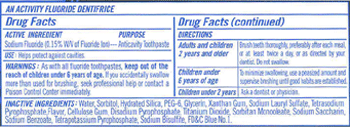2 Fluoride or Not Fluoride – That is the Question for the Public Water Supply
Is fluoride an obsolete mineral that community water utilities in the United States should revisit? Have the designated safe dosage levels of fluoride been overestimated? Is it possible that the American Dental Association, American Medical Association, along with Mayo Clinic, are decades behind in research on this topic? What was once considered a health benefit is now considered by many experts to be a health hazard. What is the real truth surrounding the use of fluoride?
EUROPE’S APPROACH
In Europe, the overall sentiment according to fluoridealert.org is that fluoride is a “drug” and, as such, the government should not be in the business of delivering an optional drug. Yes, as an American, I knew that Europe did not include fluoride in their communities’ water, but I was never given the precise reason as to why. Hearing this viewpoint, I found this topic very interesting which lead me to delve a little deeper into the subject.
Public Policy and Drinking Water - City Water - Public Utility
History of Fluoride and Global Use
Fluoride was discovered by a Colorado dentist named Frederick McKay in the early 1900s. Fluoride was first endorsed by the A.D.A. (American Dental Association) and later the A.M.A.(American Medical Association) in the 1950s. Upon its initial introduction, and even today, fluoride remains controversial. Let me shed light on two of the issues that have been raised with respect to this “preventive mineral” called fluoride. Travel with me and examine various countries’ viewpoints on the addition of fluoride into community water supplies, various agencies that have researched this drug and hear what some world-class experts have to say about the ethical considerations of adding fluoride to drinking water.
MY EXPERTISE
While I worked for community governments for many years, set utility rates, I am not an expert on chemicals. My objective is very simple - to ask the questions, reference the sources and see IF there is a better way for us to proceed.
EXPERT OPINION
When in doubt, I turn to the experts in a given field. I sought out an expert with a background in medicine and research. What I found was a physician who was a co-recipient of the Nobel Prize in Physiology or Medicine in 2000. Mr. Arvid Carlsson is a Swedish scientist who worked diligently on Parkinson’s disease. Dr. Carlsson, stated:
"I would advise against fluoridation. Individual prophylaxis (treatment) is preferable on principle grounds and is as equally effective," According to: http://www.slweb.org/carlsson.html.
FLUORIDE AND CANCER – NO DIRECT LINK With respect to the linking of cancer to fluoride, according to fluoridealert.org, the conclusion is very clear and concise
“Cancer : Weight of evidence does not support a link between exposure to fluoride and an increased risk of cancer. It is important to avoid any generalization and over interpretation…”
WHERE IS FLUORIDE?
Where is fluoride? Fluoride can be found in our community drinking water, our mouth wash, our toothpaste; fluoride can be taken in tablet form or “painted” directly on the teeth. Fluoride can also be found occurring naturally in high levels in our aquifers.

Fluoride Action Network (FAN)
Fluoride Action Network is an international coalition seeking to broaden public awareness about the fluoride compounds and the health impacts.
Two excellent reports issued by Fluoride Alert org are:
50 Reasons To Oppose Fluoridation http://www.fluoridealert.org/50-reasons.htm and also
10 Facts About Fluoride http://www.fluoridealert.org/fluoride-facts.htm
WHAT IS FLUORIDE?
As the label above clearly demonstrates sodium fluoride is a “drug” and must be labeled an active ingredient.
FLUORIDE IS A DRUG - IT IS A "MEDICINE"
Medicine according to askoxford.com is a • noun 1.) the science or practice of the treatment and prevention of disease. 2.) a drug or other preparation taken by mouth in order to treat or prevent disease. (Source: askoxford.com as assessed on 11/24/2009)
Fluoride is added to the community water supply to help with prevention. It is not chlorine, which is added for safety, it is purely a medicine which you can purchase at a drug store.
Fluoride is a drug that is added to toothpaste. Fluoride can be purchased in tablet form. Whatever method, fluoride is clearly a medicine.
AS WITH ALL DRUGS - ONE SIZE DOES NOT FIT ALL
Fluoride is added to the community water to treat the body specifically for the purpose of preventing dental decay. The problem with delivering this medicine via the water supply is it is treated as one-dose, one size fits all – and everyone who has taken any medicine knows that individuals respond very differently.
As a tap water additive, there are huge variations in consumption and age of the consumer – from infant to the aging senior not to mention level of consumption – for example, athletes and diabetic patients drink more water.
For a drug, you need to deliver in correct proportion – this is not delivered in “proper” proportion. Additionally, the introduction of this drug in our water supply is vastly wasted as over 90% of the water in a household is for bathing, cleaning, cooking – completely useless.
For infants and the elderly, should fluoride be in our community water supply? With the changing demographics here in the United States, the percentage of the elderly will climb substantially. Isn't it time to revisit this 60-year-old controversial issue?
THERE ARE BETTER WAYS OF DELIVERING FLUORIDE
One of the points delivered by FAN in its10 Facts About Fluoride that hit home with me – is “There are better ways of delivering fluoride than adding it to water. By adding fluoride to everyone's tap water, many infants and other at-risk populations will be put in harm's way. This is not only wrong, it is unnecessary. As western Europe has demonstrated, there are many equally effective and less-intrusive ways of delivering fluoride to people who actually want it.”
INFORMED CONSENT
While I can't currently support the toxity claims about fluoride, I can clearly see that fluoride is a "drug" and as such it should be treated with the same respect given to every individual as a choice, an option.
Medical ethics dictate “informed consent” yet we are delivering fluoride without individual consent.
MEDICAL CHANGES IN DENTISTRY FOR ANTIBIOTICS
In 1976, I had open heart surgery. Every time I went to the dentist, even for a simple cleaning, I needed antibiotics. Here is what the A.D.A. stated, “For decades, the American Heart Association (A.H.A.) recommended that patients with certain heart conditions take antibiotics shortly before dental treatment. This was done with the belief that antibiotics would prevent infective endocarditis (IE), previously referred to as bacterial endocarditis. IE is an infection of the heart’s inner lining or valves, which results when bacteria enter the bloodstream and travel to the heart. Bacteria are normally found on the skin and in the mouth.
The A.H.A.’s latest guidelines were published in its scientific journal, Circulation, in April 2007 and there is good news: the AHA recommends that most of these patients no longer need short-term antibiotics as a preventive measure before dental treatment.”
So the question that comes immediately to mind is, is the status of the recommendation for the addition of fluoride in community water still a valid addition and suitable to our society’s goals and objectives?
REGULATORY CHANGES - FDA AND BOTTLE WATER CLAIMS
In regards to bottle water claims and fluoride, the ADA.org website provided this information:
The U.S. Food and Drug Administration (F.D.A.) recently announced that it will allow bottlers to claim that fluoridated water may reduce the risk of tooth decay. “Whether you drink fluoridated water from the tap or buy it in a bottle, you’re doing the right thing for your oral health,” says A.D.A. executive director James B. Bramson, D.D.S. “Thanks to the F.D.A.’s decision, bottlers can now claim what dentists have long known—that optimally fluoridated water helps prevent tooth decay.”
The A.D.A. agrees with the FDA that this health claim is not intended for use on bottled water marketed to infants for whom lesser amounts of fluoride are appropriate. The appropriate amount of fluoride is essential to help prevent tooth decay. But fluoride intake above optimal amounts creates a risk for enamel (dental) fluorosis in teeth during their development before they erupt through the gums. Read more about how children can get the optimal amount of fluoride to protect their teeth.”
And here is the A.D.A.’s position on Community water fluoridation:
“The American Dental Association position on Community Water Fluoridation
• All water, including lakes, rivers and the ocean, contains naturally occurring amounts of fluoride. If the natural level of fluoride in water is very low, public water systems may adjust it to an optimal level proven to help prevent tooth decay--approximately 1 part of fluoride dissolved in a million parts of water. This process is called community water fluoridation.
• Based on the weight of scientific evidence, which indicates that community water fluoridation can help prevent up to 40 percent of tooth decay, the American Dental Association remains a strong advocate for community water fluoridation. The World Health Organization, the American Medical Association, the Centers for Disease Control and Prevention as well as the ADA and many other health organizations acknowledge that water fluoridation is a public health measure that has contributed to a significant decline in dental decay over the past 70 years.”
Nov. 10, 2009
Infants and Fluoride:
"The conservative American Dental Association (ADA) altered its position on fluoride for babies to align with the strong opposition of fluoride for babies adopted by the Natural Solutions Foundation. The ADA now recommends that babies younger than one year should not be exposed to fluoride either in water or as an ingredient in fluoride since it causes dental fluorosis (discoloration and weakening of teeth), now classified by the National Research Council as a major health problem."
Following Europe and their rejected of fluoride is not a good reason. Exploring the reason why Europe rejected community fluoridation is the item which we need to closely review.
Essentially, new mothers should not have to worry about fluoride from their tap water.
And while the date of the ADA Report on Fluoride report was November 10, 2009, I must share with you some fairly recent expert opinions emerging here in the United States:
Public Policy and Public Drinking Water
THE PROFESSIONAL OPINION IS CHANGING IN THE UNITED STATES
Prior to 2006, the professional opinion here in the United States appears to have been a unified sentiment promoting the preventive claims of fluoride.
Recently, Youtube.com has begun showing various dentists who have revisited this controversy and, they too, have changed their viewpoint: For a professional perspective, please view this video:
Fluoride and the Public Policy Debate for Drinking Water
DENTAL CARE STANDARDS
Dental care standards have been very clearly established. Always brush your teeth after every meal, avoid sugars, brush for at least 2 minutes, floss at least once a day, and your gums are as important as your teeth in dental care.
Flossing in between your teeth removes food debris and plaque (a film of bacteria on the surface of the teeth) in between the teeth that a toothbrush cannot reach. Plaque causes tooth decay (decay is a decline from a state of excellence; to deteriorate) and can lead to gum disease (plaque buildup extends below the gum line, the line between the teeth and the gums, becomes inflamed as the debris or plaque builds up and pulls the gum away from the teeth).
Baking Soda without Aluminum

MAKE YOUR OWN TOOTHPASTE – TRY ALUMINUM FREE
And speaking of dental care standards, Grandma taught us when we ran out of toothpaste, to simply grab the 3 parts baking soda baking soda (sodium bicarbonate) and one part salt for a very basic toothpaste. A more palatable version is to add household hydrogen peroxide and peppermint oil or cinnamon for added flavor.
Recently I purchased baking soda from Bob’s Red Mill which is aluminum free. I am told – haven’t tried this – when baking, use only baking soda that is aluminum free, it will dramatically affect the taste of what you are baking. And for toothpaste, it does taste different. Not much better – still pretty gritty basic toothpaste but it is a different flavor.
For me, I prefer regular store bought toothpaste complete with fluoride. I don’t mind the occasional Grandma version but those smooth gels are much more palatable for me. And toothpaste is exactly where I want my fluoride.
SUMMARY
For years, I worked for premier community governments and heard the questions about “fluoride”. For years, I believed the A.D.A. and the A.M.A. Now, with the advent of the internet and reviewing the opposing concerns combined with the reasoning Europe has consciously given for not including fluoride, I believe at the very least that the A.D.A., A.M.A. and Mayo Clinic need to review this topic once again. What we did back in the 1950s may not be pertinent given our new standards of excellence and standards of research.
Fluoride and the controversy that surrounds this drug demands, at the very least, revisiting the use of this drug in community water supplies. A re-examination of the facts after 50 years of research and review is deemed prudent and in the best interests of local government and its citizens. One of the questions which must be addressed is “is it ethical for a utility to include a medicinal drug in the water supply?” and likewise “Is this part of the utility’s jurisdiction/mission to its community?” In this new age of green and being environmentally responsible, I believe public sentiment would prefer to allow the consumer to visit the drug store for the added fluoride; to purchase toothpaste with fluoride, but fluoride clearly has no place in the public water supply.
MY PERSONAL VOTE
Upon reading the research, my personal vote is to keep fluoride in toothpaste and only in toothpaste.
While I am not a scientist, I continue to support fluoride for children but question the need for the adults and wish for more research on the use in the community water supply and wish for more research of the affects of fluoride in our aging populace. Fluoride is fully disclosed in toothpaste and I feel is properly positioned in that form. I must question the needed expense of a drug to water my lawn, etc...
What do you think?
Should Water Utilities Add Fluoride to the Community Water Supply?
If you Found This Article Helpful - Rate It Up!
If you found this article of use and helpful, please share with others. Also, use the green rate it up box to let others know how you felt about this information.
Thank you!
Articles About Fluoride
- The REAL truth about water fluoridation
Enjoy Writing? Sign up to HubPages here >> Its Free to join. The more you write, the more you can earn. Water fluoridation has been a controversial topic for a long time, but much of the general population... - Can't Sleep? Try a Natural Heavy Metal & Fluoride De...
If you've tried all the traditional and alternative methods for insomnia and nothing seems to work, there is a good chance the problem lies within the center of your brain- in your pineal gland. This important... - Buy Sarakan toothpaste without Fluoride and Organic ...
If like me you don't want to use toothpastes that contain Fluoride you may have to shop around to find good alternatives without the harmful ingredient. We all want to keep our teeth and gums healthy but it... - Why is Fluoride Bad for You?
If someone told you that every time you turn on your tap to get a drink of water you are pouring poison into your glass you probably wouldn't be so keen on drinking the resulting fluid. If you were told that...
© 2009 Kelly A. Kline








